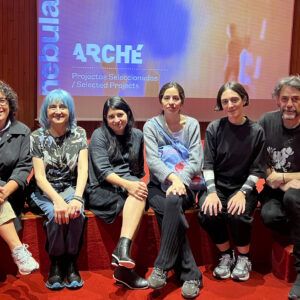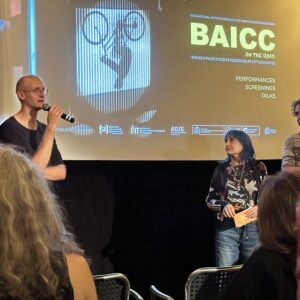This year, we wish to bring to the front the utopian film work by Spanish filmmaker and architect Juan Sebastián Bollaín, to whom we’re devoting two on-site film screenings and an online program. His most emblematic work, the tetralogy Soñar con Sevilla, was created within the framework of a broader research project that encompassed a publication. Down below you’ll find an excerpt of the book that complemented Bollaín’s films, El cine y el hecho urbano.
After a long research process on cinema as a tool for architecture and urban planning, it is necessary to look into the most valuable aspects of cinematic language: the potential to invent, create, and suggest new spaces that do not exist yet, with the aim to propose new alternatives. Our research has exclusively focused on identifying and applying these possibilities of the cinematic language by the means of an experimental film titled Soñar con Sevilla.
WHAT CAN CINEMA DO FOR US?
Our work relies on a series of ideas: methodological, technical, and conceptual ideas regarding editing and the mise en scene. Our point of departure was the very essence of cinema, that is, the “specifically cinematic”. The purpose of this first research, which was fruitful only partly, was to reflect on the medium with the aim to find a possible path to approach, as directly as possible, the suggestive exercise of “breaking time and space” in the most open, plural, suggestive, and direct way possible.
What is it that cinema, due to the specific qualities that define it, offered us? Even though we won’t linger over this excessively theoretical question, we should bear in mind something that has historically been linked to many efforts made with the aim to find the right answer to it. Ever since Ricciotto Canudo (Manifesto of the Seven Arts) initiated, in the early 20th century, the theoretical research devoted to finding the specificity of cinema, arguing that it is not theater, not melodrama, nor photography (even though it comprises something of all these disciplines within itself) the scholarly struggle for unearthing the true essence of cinema has not been resolved yet. An obsessive necessity emerges among scholars: that of drawing a line that separates the concept of cinema from both reality and the rest of the arts. While for Louis Delluc (Cinema et Cie) photogénie (“an extremely poetic quality of objects and people that only cinema can reveal”) was the distinguishing quality of cinema, for Léon Moussinac it was rhythm –a quality that brings cinema closer to other arts but also constitutes it as a different discipline–, and for Germaine Dulac “film creation must depart from all pre-existing aesthetics and build one that is its own”, going as far as to state that cinema is nothing but “a visual symphony”. The evolution of these early theories on cinema leads us to a series of thinkers-filmmakers who, filled with wonder, came to discover the countless possibilities of editing, to the extent of considering it “the distinguishing quality of cinema”. This early enthusiast is made apparent in statements as passionate as Dziga Vertov’s famous quote: “I am kino-eye, I create a man more perfect than Adam, I create thousands of different people in accordance with preliminary blueprints and diagrams of different kinds. I am kino-eye. From one person I take the hands, the strongest and most dexterous; from another I take the legs, the swiftest and most shapely; from a third, the most beautiful and expressive head –and through montage I create a new, perfect man.”
Kuleshov developed the concept of montage in a more scientific way than Vertov, opening the path for the great film theoreticians: Bela Balazs, who suggested that the close-up was specifically cinematic, as was editing (“with editing we can create time divisions; close-ups divide space”); Pudovkin, who broadened the notion of editing, considering other forms than merely narrative editing (associative editing, conceptual editing, directional, uncut…); Eisenstein, whose notion of Attraktionsmontage is the keystone on which rests his theory of “intellectual cinema”, a cinema of ideas. Rudolf Arnheim, in turn, brought together and systematized the previous theories with the aim to isolate the distinguishing quality of cinema; he intended to systematize montage, which, in his eyes, was synonymous with systematizing cinema. However, he was but the last of the pioneers of film theory. Now, if we take a leap in time, we observe that the theoretical study of cinema started to depart from these approaches only in the 60s, when thinkers began to propose a rational, syntactic, semiotic, structural, and ideological analysis of the empiric form of expression that is cinema. This led to establishing the actual dimensions of cinema (Metz, Pasolini, Della Volpe…). As is often the case, a certain disillusionment followed the initial optimism that one experiences when taking brand new paths, and the new trends of criticism weren’t the miracle they were supposed to be. All scholarly efforts to establish the true nature of cinema have intended to separate cinema from reality. They have attempted to determine what is that cinema takes from reality, and what makes it be a separate thing that is both “beyond” reality and different from the rest of the arts. But, if having reviewed the history of cinema and the theories intended to define it (on which our succinct summary intended to offer just a few clues), a simple thought by Guido Aristarco still manages to stir something in us, there must be a reason for it: “Reality exists (though in a very limited way) in the different pieces that make the film, but directors, by cutting or extending them according to an intimate desire, oppose their “ideal” time and space to those of reality, thus creating a new reality, separate from the actions that take place in a given place, for a given time, which are, because of this, inseparable.” But the way of theory is not the best for a filmmaker. This brief account of some of the nightmares that continue to haunt film theorists is only useful as far as it can suggest, even chaotically, the essence of the medium, helping us to rediscover it.
When we read that “cinema is the mobilization of the absurd” (Gus Bofa), that “the imaginary can be filmed” (Alain Resnais), or that “thanks to the editing it is possible to create, using documentary shots, a new conventional time and a new space, including an UNREAL SPACE” (Guido Aristarco), we are encouraged to humbly forget the organizing attempts of theory and, guided by intuition, decide to dive in the waters of the fantastic (at least when it comes to work methodologies).
Kevin Lynch (What time is this place?) supports this idea when he suggests that nothing can be seriously proposed for the future. “Fantasies of the future, as long as they are so recognized, are an enjoyment in themselves. Moreover, the creation of fantasy is a way of exploring future alternatives and suggesting new modes of action” (…) “By presenting [data from the real world] in novel patterns, artistic inventions alter our sensibilities –change what we see and therefore how we conceive the world.” André Breton’s ideas prove useful, too: “Utopia is more efficient than pragmatism.” Henri Lefebvre explains his concept of valid utopia, which leads him to propose “a daring, unfeasible project that would oppose the natural city…” Kevin Lynch understood like nobody else the potential of cinema for helping us invent the future: “Of all the arts, film is perhaps the most instructive for us, since its material basis is visible change. Its very popularity as a spectacle but also as a creative medium among serious young filmmakers indicates its closeness to our emerging world view. It accommodates movement in both time and space, in relation to an observer who is himself moving and changing. In film, time can be accelerated or decelerated, reversed, or dwelt upon, vaulted in either direction. Each of these distortions evokes powerful emotions in the observer. Unlike literature, there are no explicit tenses or temporal conjunctions. This lack may breed confusion but confers great freedom and immediacy. As in environmental design, the potential dimensions of film are rich and complicated: color, light, form, movement, narrative, sound, dialogue. Films usually tell a story, but the underlying structure is a rhythm of attention enforced by the sequence of scenes or takes. This rhythm must be appropriate to the perceptual expectations of the audience. The juxtaposition of scenes produces associative images in the mind of the viewer. Several different times may be compressed into one brief span. Different emotional sensations are attached to spatial positions –up, down, back, front, to, from, spacious, cramped– but even more to temporal positions –past, future, fast, slow, suspense, shock. Space and time modify each other: the idea of a space is built up by a temporal sequence of scenes; time is enriched by cramming it with spatial experience. The camera moves in both dimensions, transforming one into the other and reducing the two to emotional coherence.”






